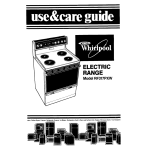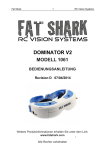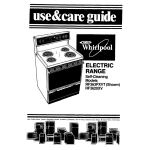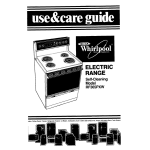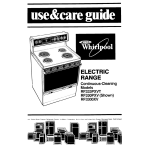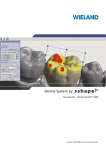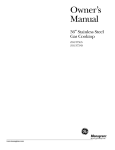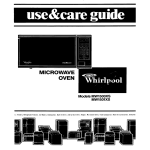Download Whirlpool RF310PXX Specifications
Transcript
ELECTRIC RANGE Contents BEFORE YOU USE YOUR RANGE IMPORTANT SAFETY INSTRUCTIONS. ............... PARTS AND FEATURES. ......... USING YOUR RANGE. .......... Using the Surface Units ....... Home Canning Information. Setting the Clock ............ Using the Minute Timer. ...... Baking or Roasting .......... Setting the Oven Controls . How To Position Racks andPans ............... How To Use Aluminum Foil for Baking. .............. Broiling ..................... Setting the Oven Controls Custom Broil .............. Broiling Tips ............... Page 2 3 5 6 6 8 9 9 10 10 11 12 13 13 13 14 01990 Whirlpool Page Adjusting the Oven Temperature Control 15 The Oven Vent. 16 The Storage Drawer 16 Optional Door Panel Pat 17 CARING FOR YOUR RANGE 18 Control Panel and Knobs 18 Surface Units and Reflector Bowls 19 Lift-Up Cooktop . . . 21 The Oven Door . .. 21 The Oven Window . 22 . . 22 Standard Oven Cleaning Cleaning Chart 23 The Oven Light 24 IF YOU NEED SERVICE OR ASSISTANCE. . . 26 WHIRLPOOL RANGE WARRANTY . 28 Corporation Before you use your range You are responsible for: l Reading and following all safety precautions in this Use and Care Guide. . Installing and leveling the range on a floor strong enough to support its weight, and where it is protected from the elements. (See the Installation Instructions.) . Making sure the range is not used by anyone unable to operate it properly. l Properly maintaining the range. l Using the range only for jobs expected of a home range. . Making sure the range is secured by a properly installed anti-tip bracket, with a rear leveling leg positioned under bracket. IMPORTANT SAFETY INSTRUCTIONS . Read all instructions before using the range. l Install or locate the range only in accordance with the provided Installation Instructions. It is recommended that the ran e be installed by a qualifie 8 installer. The ran e must be properly connet 3ed to electrical supply and l g:unded. l l l l l l l To reduce the risk of tipping of the appliance, the appliance must be secured by a properly installed anti-tip bracket. To check if the bracket is installed properly, remove the storage drawer (see page16 and verify that the antitip brat I et is engaged. Do not use the range for warmin or heating the room. Persons cou 7 d be burned or injured, or a fire could start. Do not leave children alone or unattended in area where the range is in use. They should never be allowed to sit or stand on any part of the range. They could be burned or injured. Do not wear loose or hanging garments when using the range. They could ignite if they touch a hot surface unit or heating element and you could be burned. Do not repair or replace any part of the range unless specifically recommended in this manuaLAll other servicin should be referred to a qualified ?echnician. Do not store flammable materials in or near the range. They could explode or burn. Do not use water on grease fires. l l l l l Never pick up a flaming pan. Smother flamin pan on cooktop by covering wrtI a well-fitted lid, cookie sheet or flat tray. Flaming grease outside of pan can be extinguished with baking soda or, if available, a multipurpose dry chemical or foam-type extinguisher. Use only dry potholders. Moist or damp potholders on hot surfaces may result in burns from steam. Do not let potholder touch hot heating elements. Do not use a towel or bulkv cloth for a botholder. Thev could catch on fire. Select a pan with a flat bottom that is about the same size as the surface unit. If pan is smaller than the surface unit, some of the heating element will be exposed and may result in the igniting of clothing or potholders. Correct pan size also improves cooking efficiency. Never leave surface units unattended at high heat settings. A boil-over could result and cause smoking and greasy spill-overs that may ignite. Make sure the reflector bowls are in place during cooking. Cooking without reflector bowls may subject the wiring and components underneath them to damage. Do not line reflector bowls with aluminum foil or other liners. Improper installation of these liners may result in a risk of electric shock or fire. Check to be sure glass cooking utensils are safe for use on the cooktop. Only certain types of glass, glass-ceramic, ceramic, earthenware or other glazed utensils are suitable for cooktops without breaking due to the sudden change in temperature. continued on next page 3 Turn pan handles inward, but not over other surface units. This will help reduce the chance of burns, igniting of flammable materials, and spills due to bumping of the pan. Do not soak removable heating elements in water. The element will be damaged and shock or fire could result. Use care when opening oven door. Let hot air or steam escape before removing or replacing food. Do not heat unopened containers. They could explode. The hot contents could cause burns and container particles could cause injury. Keep range vents unobstructed. Always position oven rack in desired location while oven is cool. If rack must be moved while oven is hot, do not let potholder contact hot heating element in oven. Do not clean door seal. It is essential for a good seal. Care should be taken not to rub, damage, or move the seal. Clean only parts recommended in this Use and Care Guide. l l l l l l l Do not store things children might want above the range. Children could be burned or Injured while climbing on it. l Do not touch surface units, areas near units, heating elements or interior surfaces of oven. Surface units and heating elements may be hot even though they are dark in color. Areas near surface units and interior surfaces of an oven become hot enough to cause burns. During and after use, do not touch, or let clothing or other flammable materials contact surface units, areas near units, heating elements or interior surfaces of oven until they have had sufficient time to cool. Other surfaces of the range may become hot enough to cause burns; such as, the oven vent opening, the surface near the vent opening, the cooktop, the oven door and window. . FOR YOUR SAFETY. DO NOT STORE OR USE GASOLINE OR OTHER FLAMMABLE VAPORS AND LIQUIDS IN THE VICINITY OF THIS OR ANY OTHER APPLIANCE. THE FUMES CAN CREATE A FIRE HAZARD OR EXPLOSION. l - SAVE THESE INSTRUCTIONS Thank you for buying a Whirlpool appliance. mail the Owner Registration Card provided complete the form below. Have this information or call with a question. l l Copy model and serial numbers from plate (behind the oven door on the oven frame] and purchase date from sales slip. Keep this book and the sales slip together in a handy place. ’ - Please complete and with this product. Then ready if you need service Model Number Serial Number Purchase Service Date Company Phone Number parts and features MOWS RF34Wxx and RF3105~ CLOCK/ OVEN JEMPERATURE TIMER CONTROL 1 MItWE OVEN SFJLCTna SURFACE UNIT u 11.m-- I OVEN RAc, REMOVABLE STORAGE DRAWER Using your range Using the Surface Units Surface Unit Markers PUSH IN The solid dot in the surface unit marker shows which surface unit is turned on by that knob. Surface Heating Indicator Light I 1 Control knobs must be pushed in before turning them to a setting. They can be set anywhere between HI and OFF. The SURFACE HEATING Indicator Light on the control panel will glow when a surface unit is on. I Burn and Fire Hazard Be sure all control knobs turned to OFF and all indicator lights are OFF when you are not cooking. Someone could be burned or a fire could start if a surface unlt is accidentally 1left ON. are Until you get used to the settings, use the following as a guide. For best results, start cooking at the high settings; then turn the control knob down to continue cooking.Turn on the surface unit only after placing filled pan on unit. Use HI to start foods cooking; to bring liquids to a boil. Use MED-HI to hold a rapid boil; to fry chicken or pancakes. Use MED for gravy, puddings and icing; to cook large amounts of vegetables. Use MED-LO to keep food cooking after starting it on a higher setting. Use LO to keep food warm until ready to serve. Set the heat higher or lower within the LO band to keep food at the temperature you want. Cookware There is no one brand of utensil that is best for all people. Knowing something about pan materials and construction will help you select the right cooking utensils for your needs. 1. Use only flat-bottomed utensils that make good contact with the surface units. To check the flatness of a utensil: l Turn it over and check the bottom of the pan by placing a ruler across it. l Rotate the ruler in all directions. There should be no gaps between the pan and the ruler. 6 2. The pan should have straight sides and a tight-fitting lid. 3. Choose medium to heavy gauge (thickness] pans that are fairly lightweight. Remember that a very heavy pan will be even heavier when filled with food. 4. The pan material (metal or glass) affects how fast heat transfers from the surface unit through the pan material and how evenly heat spreads over the pan bottom. 5. Handles securely should be made of a sturdv, heat-resistant attached to the pan. ’ material and be Burn, Personal Injury and Product Damage Hazard If the pan is too small for the surface unit, you could be burned by the heat from the exposed section of the surface unit. Use correctly sized cooking utensils to prevent injury. l Not all glass, glass-ceramic, ceramic, earthenware and other glazed utensils are safe for cooktop cooking. Some will crack or break with sudden temperature changes, which could result in personal injury. . If a surface unit stays red for a long time, the bottom of the pan is not flat enough or is too small for the surface unit. Prolonged usage of incorrect utensils for long periods of time can result in damage to the surface unit, cooktop, wiring and surrounding areas. To prevent damage, use correct utensils, start cooking on HI and turn control down to continue cooking. l Do not leave an empty utensil, or one which has boiled dry, on a hot surface unit. It can overheat and may damage the utensil or surface unit. l Do not use canners, woks and specialty utensils with rounded, warped, ridged or dented bottoms. These could cause severe overheating which damages the utensil and/or surface unit. l 7 Home Canning Information To Protect Your Range: 1. Use flat-bottomed canners for best results. Do not use canners with dented or ridged (porcelain enamel-ware] bottoms. They do not make good contact with the surface unit and cause severe over-heating which damages the cooktop. 2. For best results, use a canner which can be centered over the surface Large diameter canners, if not properly centered, trap heat and can cause damage to the cooktop. unit. 3. Do not place canner build-up will damage heat 4. Alternate batches. surface on two surface the cooktop. units at the same time. Excessive units. This allows the surface units to cool down between 5. Start with hot water. This reduces the time the control is set on high. Reduce heat setting to lowest position needed to keep water boiling. 6. Keep reflector bowls clean for best heat reflection. 7. To prolong the life of the elements: l Prepare small batches at a time. . Do not use elements for canning all day. OptiOnal Canning Kit (Part NO. 242905) The large diameter of most water-bath or pressure canners combined with high heat settings for long periods of time can shorten the life of regular surface units and cause damage to the cooktop. If you plan to use the cooktop for canning, we recommend the installation of a Canning Kit. Order the kit from your Whirlpool dealer or authorized WhirlpoolSM service company. Setting the Clock Push In and turn the Minute Timer Knob to set the Clock. 1. Push in Minute Timer Knob and turn clockwise until clock shows the right time of day. 2. Let the Minute Timer Knob pop out. Turn clockwise until Minute Timer hand points to OFF. The clock setttng will change If you push In the knob when turning. Using the Minute Timer The Minute Timer does not start or stop the oven. It works like a kitchen timer. Set it in minutes up to an hour. You will hear a buzzer when the set time is up. DO NOT PUSH IN THE KNOB when setting the Minute Timer. 1. WIthout pushlng It In, turn the Minute Timer Knob until the timer hand passes the setting you want. 2. Wlthout pushlng in, turn the knob back to the setting you want. When the time is up, a buzzer will sound. To stop the buzzer, turn the Minute Timer hand to OFF. PUSHING IN AND TURNING THE MINUTE TIMER KNOB CHANGES SETTING. THE CLOCK Baking or Roasting Setting the Oven Controls 1. Position the rack(s) properly before turning on the oven. To change rack position, lift rack at front and pull out. For information on positioning racks, see “How To Position Racks and Pans” on page 11. 2. Set the Oven Selector 3. Set the Oven Temperature Control to the baking temperature you want. The OVEN HEATING Indicator Light will come on. The oven is preheated when the OVEN HEATING Indicator Light first goes off. NOTE: Do not preheat oven when roasting or cooking items such as casseroles. 5. When baking is done, turn both the Oven Selector and Oven Temperature Control to OFF The OVEN HEATING Indicator Light will go off. 10 to BAKE. 4. Put food in the oven. During baking, the elements will turn on and off to keep the oven temperature at the setting. The OVEN HEATING Indicator Light will turn on and off with the elements. The top element helps heat during baking, but does not turn red. How To Position Racks and Pans The rack(s) should be placed so the top of the food will be centered in the oven. Always leave at least IM to 2 inches (4-5 cm) between the sides of the pan and the oven walls and other pans. For proper cooking, follow these guidelines for specific foods: l Angel and bundt cake pans, yeast breads, frozen pies, large roasts and turkeys - place rack on lowest level l Casseroles, muffins, most quick breads and meats - place rack on second level from bottom l Cookies, biscuits, cakes and non-frozen pies - place rack on second or third level from bottom When baking bottom. on two racks, arrange racks on bottom and third level from Fire and Personal injury Hazard Always position oven racks in desired location before turning oven on. Be sure the racks are level. l if racks must be moved while oven is hot, use potholders or oven mitts to protect hands. l Do not let potholders or oven mitts contact hot heating elements. l Always use a dry potholder or oven mitt to change racks or handle utensils in the oven. Do not use a damp potholder or oven mitt. Steam burns could result. Failure to follow the above precautions may result in fire or personal injury. l The hot air must circulate around the pans in the oven for even heat to reach all parts of the oven. How to Use Aluminum Foil for Baking: For Best Air Circulation: Place the pans so that one is not directly over the other. l Allow lY2-2 inches (4-5 cm] of space around each pan and between pans and oven walls. l Use only one cookie sheet in the oven at one time. Use the following as a guide to determine where to place the pans. l Use aluminum foil to catch spill-overs from pies or casseroles. l Place the foil on the oven rack below the rack with the food. The foil should have the edges turned up and be about 1 inch (3 cm) larger all around than the dish holding the food. l Do not cover the entire rack with aluminum foil. It will reduce air circulation and cause poor cooking results. One Pan Place in the center of the oven rack. Two Pans Place in opposite corners of the oven rack. NOTE: “Oven peeking” may cause heat loss, longer cooking times and unsatisfactory baking or roasting results. Rely on your timer. l l Electrical Shock, Fire and Product Damage Hazard Do not allow foil to touch the heating elements because it will damage them and could result in shock or fire hazard. Do not line Standard Oven bottoms with foil or other liners. Poor baking will result. Broiling Setting the Oven Controls 1. Position the rack properly before turning on the oven. The oven rack should be positioned so that the surface of the food is at least 3 inches (7.4 cm) away from the broil element. 2. Put the broiler the rack. pan and food on 3. Close the door to the Broil Stop position (open about 4 inches, 10.2 cm]. The door will stay open by itself. NOTE: The door must be partly open whenever the oven is set to BROIL. Leaving the door open allows the oven to maintain 4. Set the Oven Selector and Oven Temperature Control to BROIL. The OVEN HEATING Indicator Light will come on. NOTE: Do not preheat broiling. oven when 5. When broiling is done, turn both the Oven Selector and Oven Temperature Control to OFF The OVEN HEATING Indicator Light will go off Custom Broil l l If food is cooking too fast, turn the Oven Temperature Control counterclockwise until the OVEN HEATING Indicator Light goes off. If you want the food to broil slower from the start, set the Oven Temperature Control between 150” and 325°F (65.5” and 162.7”C). The lower the temperature, the slower the cooking. The Oven Selector must be on BROIL for ail broiling temperatures. 13 Broiling Tips l l l Use the broiler pan and grid for broiling. They liquid and fat away from the cooking surface or fire. Refer to a broiling chart in a reliable cookbook After broiling, remove the broiler pan from the food. Drippings will bake on the pan if it is left l l are designed to drain excess to help prevent spatter, smoke for correct broiling times. oven when you remove the in the heated oven. Fire Hazard Place meat the correct distance from the element. Meat placed too close to the element may spatter, smoke, burn or catch fire during broiling. To ensure adequate grease drainage, do not use cookie sheets or similar pans for broiling. Also, covering the broiler grid with foil is not recommended. Poor drainage of grease may result in fire. If foil is used, cut slits in foil to correspond with all openings in broiler grid. Grease can then drain away and cool in pan. Adjusting the Oven Temperature Control Does your oven seem hotter or colder than your old oven? The temperature of your old oven may have shifted gradually without your noticing the change. Your new oven is properly adjusted to provide accurate temperatures. But when compared to your old oven, the new design may give you different results. If after using the oven for a period of time, you are not satisfied with the temperature settings, they can be adjusted by following these steps: LOCKING SCREWS 1. Pull the Oven Temperature Knob straight off. TOdTH Control NOTCHES 3. To lower the temperature, move the tooth a notch closer to LO. Each notch equals about 10°F (5°C). 2. Loosen the locking screws inside the control knob. Note the position ot the notches. TOtiTH I N6TCHES 4. To raise the temperature, move the tooth a notch closer to HI. Eact notch equals about 10°F (5°C). Tighten replace the locking the control screws knob. and The Oven Vent Hot air and moisture escape from the oven through a vent under the right rear surface unit. You can cook on the unit, or keep food warm on it while the oven is on. Burn Hazard If you leave a utensil on the right rear surface unit, use potholders when moving It. Pan handles can become hot enough to burn. Plastic utensils iett over the vent can melt. The vent is needed for air circulation. Do not block the vent. Poor baking can result. The Storage Drawer The storage drawer is for storing pots and pans. The drawer can be removed to make it easier to clean under the range, and to check for installation of the anti-tip bracket. Use care when handling the drawer. Removing the storage drawer 1. Empty drawer of any pots and pans before removing drawer. Pull drawer straight out to the first stop. Lift front and pull out to the second stop. 16 2. Lift back slightly andyde all the way out. drawer Replacing 1. the storuge drawer Fit ends of drawer sli~rails into the drawer guides on both sides of opening. 2. Lift drawer front and push in until metal stops on drawer slide rails clear white stops on drawer guides. Lift drawer front again to clear second stop and slide drawer closed. To verity the anti-tip bracket is engaged: l Remove the storage drawer. l Look to see if the anti-tip bracket is attached to floor with screws. l Make sure one rear leveling leg is positioned under the anti-tip bracket. l See Installation Instructions for further details. Optional Door Panel Pat [Model RF310PXX) If you would like to change the color of your oven door glass to white or almond, you can order one of these kits: White (Kit No. 814069) or Almond (Kit No. 814070) from your Whirlpool Dealer. The kits include easy installation instructions. Caring for your range Control Panel and Knobs Burn and Electrical Shock Hazard Make sure all controls are OFF and the range is cool before cleaning. Failure to do so can result in burns or electrical shock. 1. Turn control 2. Pull control knobs to the OFF position. knobs straight off. 3. Use warm soapy water or spray glass cleaner, control panel. Rinse and wipe dry 4. Wash control 5. Replace knobs in warm soapy control knobs by pushing and a soft cloth, to wipe the water. Rinse well and dry. Do not soak. them firmly into place. NOTE: When cleaning, never use steel wool, abrasives, cleaners which may damage the finish. After cleaning, knobs point to the OFF position. 18 or commercial oven make sure all control Surface Units and Reflector Bowls Removing 1. Turn off all surface 2. Lift the edge of the unit, opposite the receptacle, just enough to clear the element hold down clip and the reflector bowl. units. 3. Pull the surface unit straight from the receptacle. away 4. Lift out the reflector bowl. See “Cleaning Chart” on page 23 for cleaning instructions. conilnued on next page Replacing l l Burn, Electrlcal Shock and Fire Hazard Make sure all surface units are OFF before replacing surface units and reflector bowls. Failure to do so can result In burns or electrical shock. Do not llne the reflector bowls wlth foil. Fire or electrical shock could result. . Turn off all surface units. I 3. Hold the surface unit as level as possible with terminal just started into the receptacle. Push the surface unit terminal into the receptacle. NOTE: Reflector bowls reflect heat They also help catch spills. When better and look new longer. If a reflector bowl gets dlscolored, enough, or some may be too large of the heat that’s meant to go Into the reflector bowl. lhls extra heat 20 2. Line up openings in the reflector bowl with the surface unit receptacle and the element hold down clip. I I 4. When terminal is pushed into the receptacle as far as it will go, push down the edge of the surface unit opposite the receptacle. The element hold down clip will keep the surface unit from moving around. back to the utensils they are kept clean, on the surface units. they reflect heat some of the utensils may not be flat for the surface unit. In either case, some or around a utensil goes down and heats can dlscolar it. r Lift-Up Cooktop 1. Lift front of cookto~ at both front corners until the support rods lock into place. Personal InJury and Product Damage Hazard ) Be sure both support rods are fully extended and In the locked posltlon. Failure to do so could result In personal Injury from the cook-top accidentally falling. b Do not drop the cooktop. Damage can result to the porcelaln and the cooktop frame. 2. Wipe with warm, soapy water. Use a soapy steel wool pad on heavily-soiled areas. 3. To lower the cooktop, lift cooktop from both sides while pressing the support rods back to unlock them. Lower the cooktop into place. The Oven Door Removing the oven door will help make it easier to clean the oven. Burn and Electrical Shock Hazard Make sure all controls are OFF and the oven is cool before removing oven door. Failure to do so can result in burns or electrical shock. 1. Open the door to the first stop position. 2. Hold the door at both sides and lift it at the same angle it is in. 3. To replace, fit the bottom corners of the door over the ends of the hinges. Push the door down evenly. The door will close only when it is on the hinges correcfly The Oven Window If your range has an oven window instead of the black glass door, the outer glass and frame can be removed for cleaning. DO NOT TAKE APART A BLACK GLASS DOOR. To remove the outer window: . Turn off all controls. With the door closed, remove the screws from the top of the outer window frame. . Slightly tip the window and frame out from the top. 3. With both hands, lift up on both sides of the frame. To replace the outer window: . Fit the bottom tabs of the frame into the bottom opening. ;. Replace the screws. of the window 2. Push the top of the frame into place while pushing down. Standard Oven Cleaning The Standard Oven has to be hand cleaned. Use warm soapy steel wool pads or a commercial oven cleaner. See “Cleaning page 23 for further instructions. water, soapy Chart” on Do not allow commercial oven cleaner to contact the heating elements, thermostat, oven seal or exterior surfaces of the oven. Damage will occur, Using Foil To catch sugar or starch spills from pies and casseroles, use a piece duty aluminum foil or a shallow pan on the lower rack, slightly larger cooking container. NOTE: Do not use foil or toll liner to cover could occur. of heavythan the oven floor. Poor baking the results Cleaning Chart PART WHAT TO USE HOW TO CLEAN Exterlor surfaces Warm soapy water and a soft cloth. Non-abrasive plastic scrubbing pad for heavilysoiled areas. . Wipe off regularly when range is cool. l Do not allow food contalnlng acids (such as vinegar, tomato, lemon juice or milk) to remaln on surface. Acids may remove the glossy tlnlsh. l Do not use abraslve or harsh cleansers. Surface units No cleaning required. l l Chrome retlector bowls Control Control Warm soaps water and a non-abrkive plastic scrubbing pad. knobs panel Warm soapy a soft cloth. water and Warm soapy water or spray glass cleaner and a soft cloth. Warm soapy waler or a soapy steel wool pad. Oven Warm soapy water or soapy steel wool pads. Oven door glass Spray glass cleaner l l l l Broiler pan and grld racks l l l l l l or l warm soapy water and l a non-abrasive plastic scrubbing pad. l Spatters or spills will burn off Do not immerse in water. Wash, rinse and drv well Clean frequently. Do not use abrasive or harsh cleansers. Wash, rinse and dry well. Do not soak. Wash, rinse and dry well. Follow directions provided the cleaner. with Clean after each use. Wash, rinse and dry well. Wash, rinse and dry. Use soapy steel wool pads for heavily-soiled areas. Make sure oven is cool. Follow directions provided the cleaner. Wash, rinse and dry well. continued with on next page 23 Standard oven Warm, soapy water or soapy steel wool pads. OR Commercial oven cleaners. Heavy-duty or shallow aluminum pan. Remove door for easier access. Clean heavily-soiled areas or stains. Rinse well with water. 9 Remove door for easier access. l Place newspaper on floor to protect floor surface. l Follow directions provided with the oven cleaner. l Rinse well with clear water. l Use in well-ventilated room. l Do not allow commercial oven cleaners to contact the heating elements, oven seal, thermostat or exterlor surfaces of the range. Damage will occur. l Place piece of foil or shallow pan, slightly largerthan the cooking container, on lower rack to catch spill-overs. l l foil The Oven Light The oven light will come on when you push the Oven Light Switch on the control panel. Push it again to turn off the light, To Replace: l l Electrical Shock and Personal injury Hazard Make sure oven and light bulb are cool and power to the range has been turned OFF before replacing the light bulb. Failure to do so could result in electrical shock or burns. The bulb cover must be in place when using the oven. The cover protects the bulb from breaking, and from high oven temperatures. Since bulb cover is made of glass, be careful not to drop it. Broken glass could cause injury. 1. Unplug appliance at the main power 24 or disconnect supply. 2. Remove the glass bulb cover in the back of the oven by screwing it out counterclockwise. 3. Remove the light bulb from its socket. Replace the bulb with a 40-watt appliance bulb. 4. Replace the bulb cover screwing it in clockwise. appliance or reconnect the main power supply. by Plug in at 25 If you need service or assistance, we suggest you follow these steps: Are the pans the size called 1. Before calling for recipe? l assistance... Performance problems often result from little things you can find and fix without tools of any kind. if nothing operates: Is the power supply cord plugged into a live circuit with the proper voltage? (See Installation Instructions.) l Have you checked your home’s main fuses or circuit breaker box? if the oven will not operate: l Is the Oven Selector turned to a setting (BAKE or BROIL)? l Is the Oven Temperature Control turned to a temperature setting? l if surface units will not operate: Have you checked your home’s main fuses or circuit breaker box? l Are surface units plugged in all the way? l Do the control knobs turn? l if surface unit control knob(s) will not turn: l Did you push in before trying to turn? If cooking results aren’t what you expected: l Is the range level? l Does the oven temperature seem too low or too high? See page 15. l If needed, have you preheated the oven as the recipe calls for? l Are you following a tested recipe from a reliable source? l Are you using pans recommended in the “Cookware” section on page 6? l If baking, have you allowed 1% to 2 inches (4-5 cm) on all sides of the pans for air circulation? 26 l for in the Do the cooking utensils have smooth, flat bottoms and fit the surface elements being used? 2. If you need assistance?.. Call Whirlpool COOL-LINE* service assistance telephone number. Dial free from anywhere in the U.S.: 1-800-253-1301 and talk with one of our trained consultants The consultants can instruct you in how to obtain satisfactory operation from your appliance or, if service is necessary, recommend a qualified service company in your area. If you prefer, write to: Mr. Donald Skinner Director of Consumer Relations Whirlpool Corporation 2000 M-63 Benton Harbor, Ml 49022 Please include a daytime phone number in your correspondence. 3. 5. If YOUare not satisfied widthhow the problem was solved?.. If you need service?.. Whirlpool has a nationwide network of authoSERVICE rized WhirlpoolSM service companies. Whirlpool service technicians are trained to fulfill the product warranty and provide after-warranty service, anywhere in the United States. To locate the authorized Whirlpool service company in your area, call our COOL-LINE@ service assistance telephone number (see Step 2) or look in your telephone directory Yellow Pages under: TLfl olEY 2 l 4. If you need FSP” replacement parts?.. FSP is a registered trademark of Whirlpool Corporation for quality parts. Look for this symbol of quality whenever you need a replacement partforyour Whirlpool appliance. FSP replacement parts will fit right and work right, because they are made to the same exacting specifications used to build every new Whirlpool appliance. To locate FSP replacement parts in yourarea, refertostep 3aboveorcaII the Whirlpool COOL-LINE service assistance number in Step 2 Contact the Major Appliance Consumer Action Panel (MACAP). MACAP is a group of independent consumer experts that voices consumer views at the highest levels of the major appliance industry. Contact MACAP only when the dealer, authorized servicer or Whirlpool have failed to resolve your problem. Major Appliance Consumer Action Panel 20 North Wacker Drive Chicago, IL 60606 MACAP will in turn inform us of your action. *When requesting assistance, provide: model number, number, date of purchase, complett ? description of tl lem. This information is ne order to better respond request. please serial and a WHIRLPOOL” RANGE PRODUCT WARRANTY r EROOl LENGTH OF WARRANTY WHIRLPOOL FULL ONE-YEAR WARRANTY From Date of Purchase FSP@replacement parts and repair labor to correct defects in materials or workmanship. Service must be provided by an authorized WhirlpoolSM service company. WHIRLPOOL 1 WILL PAY FOR WILL NOT PAY FOR A. Service calls to: I. Correct the installation of the range product. 2. Instruct you how to use the range product. 3. Replace house fuses or correct house wiring or plumbing. 4. Replace owner accessible light bulbs. B. Repairs when range product is used in other than normal, single-family household use. C. Pick up and delivery. This product is designed to be repaired in the home. D. Damage to range product caused by accident, misuse, fire, flood, ads of God or use of products not approved by Whirlpool. WHIRLPOOL CORPORATION SHALL NOT BE LIABLE FOR INCIDENTAL OR CONSEQUENTIAL DAMAGES Some states do not allow the exclusion or limitation of incidental or consequential damages so this limitation or exclusion may not apply to you. This warranty gives you specific legal rights, and you may also have other rights which vary from state to state. Outside the United States, a different warranty may apply. For details, please contact your franchised Whirlpool distributor or military exchange. If you need service, first see the “Service and Assistance” section of this book. After checking “Service and Assistance:’ additional help can be found by calling our COOL-LINEm service assistance telephone number, 1-800-253-1301, from anywhere in the US. @Registered Trademark/SM Service Mark of Whirlpool Part No. 3150257 01990 Whirlpool Corporation Makers. Dlshsashen. .!wII-In Ovens and Surlace Units. Ranges. Microwave Corporation Printed in U.S.A. Ovens. Trash Compactors. Room Au Conditioners, Dehumidilierr, Automatic W




























